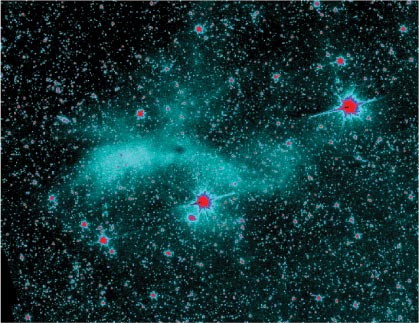Recently Discovered Phenomenon Could Reveal How Stars Are Born

Lightfrom the cosmic clouds where stars and planets are borncould soon reveal secrets about these mysterious formativeregions, a new studysuggests.
Coldmolecular clouds are the cradles of stars and planets, where denseclusters ofgas collapse to form protostars and immense clumps of dust grains canbecome Earth-likeworlds. But just how this happens is largely unknown, in partbecause theclouds shroud what’s going on, so astronomers can’t see the action invisiblelight.
Nowlight dubbed "coreshine" that emerges from the center of these cloudsmight reveal clues about how the stars and planets develop over time,researchers say. [Photoof cosmic coreshine.]
In2005, NASA's Spitzer Space Telescope discovered infrared light emergingfromthe core of a cold, starless molecular cloud roughly 400 light-yearsaway. Thiscloud, known as L183, is roughly 80 times the mass of the sun. [Gallery:Spitzer Telescope's infrared universe.]
Theinfrared beams detected from L183 were likely the result of starlightpassingthrough the cloud that got scattered off dust in its core, the cloud'sdensestregion. The specific wavelength of the rays suggest the dust grains hadto beat least 1 micron in size, or roughly a hundredth the width of a humanhair.
"Youcan think of the grains as small mirrors," said researcher LaurentPagani,an astrophysicist at the Paris Observatory. "If the mirror is muchsmallerthan the wavelength, the light will not notice the mirror."
Thissize would make each grain about 10 times wider than the average dustmotesthought to make up these clouds. As such, this radiation could yieldinsightsregarding how the construction blocks of stars and planets grow.
Get the Space.com Newsletter
Breaking space news, the latest updates on rocket launches, skywatching events and more!
Nowthe scientists reveal this coreshine effect is not limited just toL183.Instead, it is actually common in many molecular clouds across thegalaxy.Pagani and his colleagues used Spitzer to investigate the cores of 110different molecularclouds, and about half of them clearly gave off coreshine.
Furtheranalysis of coreshine should reveal details about the properties of thegrainscausing this light. Since the size of the dust grains should grow overtime,the coreshine should also shed light on the age of clouds, Pagani said,and thelocation of this radiation within the cloud could yield insightsregarding itsinternal structure.
Allthis information could ultimately help scientists understand howplanets and stars form.
"Fora long time, models of dust growth were far too slow — typical times ofhundreds of million years — and were not trustworthy," Paganiexplained. Hesaid a new model designed by his colleague Chris Ormel of the MaxPlanckInstitute for Astronomy in Heidelberg, Germany may prove more accurateandmatch the recent observations.
Paganiand his team detailed their findings in the Sept. 24 issue of the journalScience.
- Gallery:Spitzer Space Telescope's Infrared Universe
- TheStrangest Things in Space
- SomeAncient Galaxies Had Wild Youth
Join our Space Forums to keep talking space on the latest missions, night sky and more! And if you have a news tip, correction or comment, let us know at: community@space.com.

Charles Q. Choi is a contributing writer for Space.com and Live Science. He covers all things human origins and astronomy as well as physics, animals and general science topics. Charles has a Master of Arts degree from the University of Missouri-Columbia, School of Journalism and a Bachelor of Arts degree from the University of South Florida. Charles has visited every continent on Earth, drinking rancid yak butter tea in Lhasa, snorkeling with sea lions in the Galapagos and even climbing an iceberg in Antarctica. Visit him at http://www.sciwriter.us









